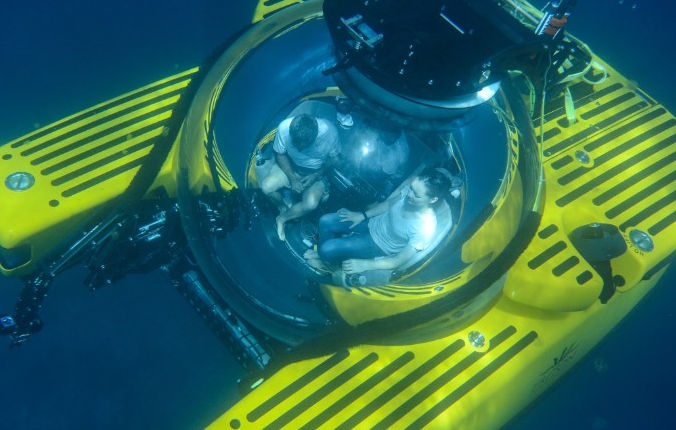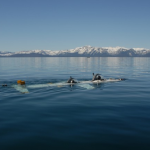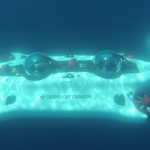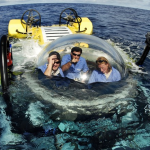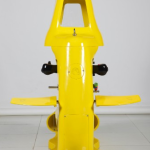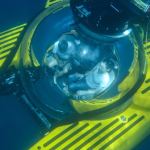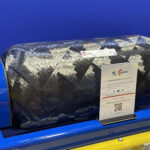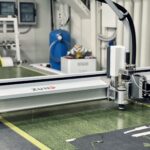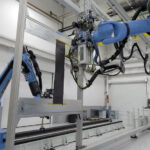Imagine yourself strapped snugly inside your own personal submarine. Your head might be surrounded by a transparent canopy, giving you a 360-degree view of an ocean wonderland.
With the touch of a small lever near your left hand, you command this sleek, 16-foot sub to go into a deep dive. On your right, a joystick lets you steer in any direction you choose: forward, back, left or right. Essentially, you’d be piloting your own underwater exploration mission. Options might include checking out an ancient shipwreck or snuggling up close to a gigantic whale.
The technology seems all so James Bond – except it’s real. The sub is called the Deep Fligt Dragon Price: about $1.5 million.
Sir Richard Branson owns one. So does Red Bull co-founder Dietrich Mateschitz. But DeepFlight doesn’t expect you to buy one. Instead, right now, you can operate a DeepFlight submarine at a posh resort and be an explorer for a day. Operating the sub is relatively simple, designers say, requiring minimal training.
The Dragon is just one of many personal submersibles now on the market. There are more than ever before, say experts, thanks to emerging technology.
These underwater ships sport cool names like Scubster, the Triton and SEAmagine. Some operate partly above and partly below the waterline, like the so-called semisubmarine, EGO-Compact. Another one, the Seabreacher X, jumps out of the water like a wild marlin on a hook. It’s a steal at only $80,000.
Composite materials open new possibilities
Why? One reason is strong, relatively new building materials that replace old-style metal. Salt water causes metal to to corrode, which obviously is a bad thing for metal submarines.
But what if most of the sub is made from something else? For example, what if it’s built with strong, lightweight composite materials that don’t rust or corrode? That’s a win. The Dragon’s pressure hull is constructed with a proprietary composite material, specially designed to withstand the pressures of ocean diving. Next year, a company called OceanGate plans to begin offering a submersible featuring a 7-inch-thick carbon fiber hull using Boeing manufacturing technology.
The underwater craft called The Scubster is also constructed of carbon fiber material, although it only dives to about 20 feet. It comes in models powered by pedals as well as electric motors. Top speed: about 5 mph.
If the Dragon’s electric power fails, or some other critical system goes sideways, the sub is designed to automatically float to the surface.
DeepFlight Dragon has a top speed of about 5 mph and is limited to a depth of about 400 feet.
That’s not very deep, compared to film director James Cameron’s record-setting mission to the bottom of the Pacific.
But depending on where you’re looking, it’s deep enough to see some cool stuff. Once you get below 400 feet, you begin to lose sunlight from above. Going deeper would require your personal sub to be weighed down by heavy lighting equipment.
The intrigue of exploring underwater
Even at relatively shallow depths, there’s something about submarine travel that ignites the human imagination.
Jules Verne blew readers’ minds in 1870 with his book “Twenty Thousand Leagues Under the Sea,” about a sub named the Nautilus. Disney’s 1954 movie based on Verne’s book used eye-popping special effects to bring the Nautilus to life.
In the 1960s, TV viewers got all excited about submarines from adventure series like “The Thunderbirds” – starring several puppets and toy models – and “Voyage to the Bottom of the Sea.” And more recently, sub-mania experienced a brief TV revival in the 1990s with “SeaQuest DSV.”
Remember that 1977 James Bond film “The Spy Who Loved Me,” featuring a white Lotus Esprit S1 sports car which converted into a submarine? Well, that vehicle never actually worked. It was just a Hollywood trick. However, the founder of DeepFlight, ocean engineer Graham Hawks, actually designed a tiny submarine that was used in a Bond film.
The sub in 1981’s “For Your Eyes Only” was called “Mantis” and came armed with pliers and drill. Maybe we’re so fascinated with submarines because humans are drawn to explore largely unknown hostile environments. Like outer space, the depths of oceans and lakes obviously are environments where humans can’t survive for long without special equipment.
Unlike space, water is easy to access and we don’t need rockets to get there. As the famous sci-fi writer Arthur C. Clarke once wrote, “Everyone who goes underwater becomes an amateur scientist.”
Now, thanks to emerging technology, more people will be able to hop inside a tiny sub and take a look.


